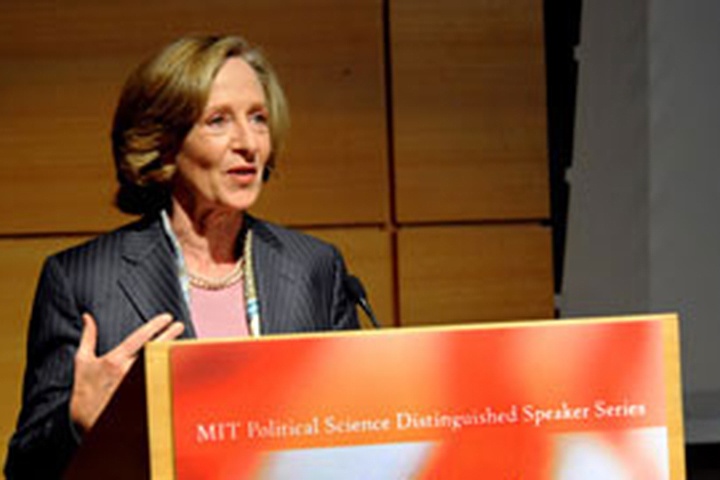MIT Political Science Distinguished Speaker Series:
American made?
MIT forum examines the role of manufacturing in rebuilding the economy.

MIT President Susan Hockfield
In 1950, more than 30 percent of Americans were employed in manufacturing, working at jobs such as welding, machining and assembly. Today, that number has shrunk significantly: Manufacturing jobs make up less than 10 percent of the U.S. workforce. As the country seeks to reinvigorate its job market and move past an economic recession, the state of U.S. manufacturing has become a hotly debated topic.
To examine manufacturing’s role in economic recovery, students, faculty and representatives of MIT’s corporate partners gathered Thursday afternoon in MIT’s Wong Auditorium for a forum on “Rebuilding the American Economy.” The event was sponsored by the Department of Political Science and by Production in the Innovation Economy (PIE), a new MIT initiative that seeks to analyze the relationship between innovation, production and job creation. Throughout the forum, participants sought answers to a pervasive question: Can the United States keep its innovative edge if it loses its production capabilities?
MIT President Susan Hockfield opened the forum by harkening back to a similar period of economic malaise in the mid-19th century — when, as it turns out, the country was on the cusp of the Industrial Revolution. At the time, MIT founder William Barton Rogers “lamented” the citizenry’s lack of scientific expertise, founding MIT, in part, to cultivate a new generation of scientists and engineers who would develop innovative materials and manufacturing processes.
“Once again, as a nation, we find ourselves at a moment of difficult transition,” Hockfield said. “After more than a century of industrial success, America needs to revise its economic assumptions once again.”
Hockfield, who has been appointed by President Barack Obama to co-chair (with Dow Chemical CEO Andrew N. Liveris) the administration’s new Advanced Manufacturing Partnership, said that in touring the country to talk with people about the state of U.S. manufacturing, she’d heard from two evenly divided camps.
“Half the people I talk to say, ‘This is the most important thing for the nation,’ and the other half look at me quite quizzically, as if to say, ‘Didn’t you get the memo? America doesn’t do manufacturing anymore’ — a very worrying response,” she says.
Made in China
Ron Bloom, who until last month served as Obama’s senior counselor for manufacturing policy, has observed a similar ambivalence. Bloom, who gave yesterday’s keynote address as part of the Department of Political Science’s Distinguished Speaker series, cited a recent poll in which only 40 percent of Americans believe the United States is the world’s economic superpower. Of the remaining 60 percent, two-thirds believe China holds the top economic spot. By way of explanation, Bloom says people simply responded, “Because China makes everything.”
While Bloom said this isn’t true — in fact, the United States manufactures about as much as China, and its GDP far eclipses that of China — there is no doubt that China is a major manufacturing force, a fact that has become synonymous with economic power in the minds of many Americans.